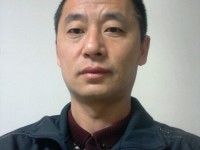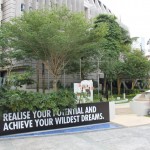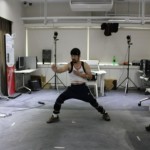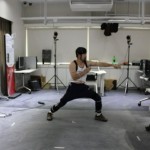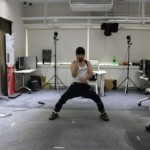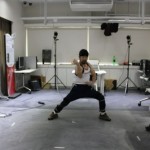 Many years ago when I was just learning Yilu, I had questions about how the “Second Closing” (the move after fetch water) was done properly. I was just imitating the movement, the hand was waving from one place to another place. I had no idea where was the energy alignment in that particular move. Master Chen explained “Second Closing” with its application and tried on me. He turned and I was on the ground. It was that simple. I didn’t know, I could not figure out how Master Chen did. But I did know how powerful the “Second Closing” was.
Many years ago when I was just learning Yilu, I had questions about how the “Second Closing” (the move after fetch water) was done properly. I was just imitating the movement, the hand was waving from one place to another place. I had no idea where was the energy alignment in that particular move. Master Chen explained “Second Closing” with its application and tried on me. He turned and I was on the ground. It was that simple. I didn’t know, I could not figure out how Master Chen did. But I did know how powerful the “Second Closing” was.
Knowledge : Articles
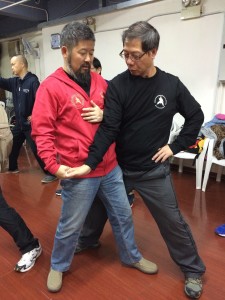 |
As the Christmas season approached, Hong Kong shimmered under dazzling festive lights, setting the perfect backdrop for a year ending workshop led by K.T. Lin and Nicholas Fung (馮嘉傑) from the Hong Kong Chen Style Taiji Practical Method (香港陳式太極實用拳法). On a pleasantly mild weekend, more than thirty dedicated practitioners from Hong Kong, Mainland China, the United States, and Canada gathered to train with Master Chen Zhonghua.
A special appreciation goes to Tim Duering and Hán Ruì (韩瑞), who traveled from Daqingshan to support the workshop. Over two transformative days, Master Chen guided participants through the core principles of the Practical Method, including foundational techniques, movement dynamics, and Yilu. Beyond the fundamentals, he also explored the deeper theory of Chen Taijiquan, offering hands-on applications and insights into the intricacies of push-hands training. |

Negative circle is likely the second thing one learns in Practical Method. The following are some starter instructions for a right-side negative circle:
- The right side is considered the front side, and the left side is consider the rear side.
- Find a line that is parallel to your chest on the ground.
- Put your right foot at 45 degrees to the line with the heel touch the line.
- Put your left foot at 90 degrees to the line with the toes touch the line.
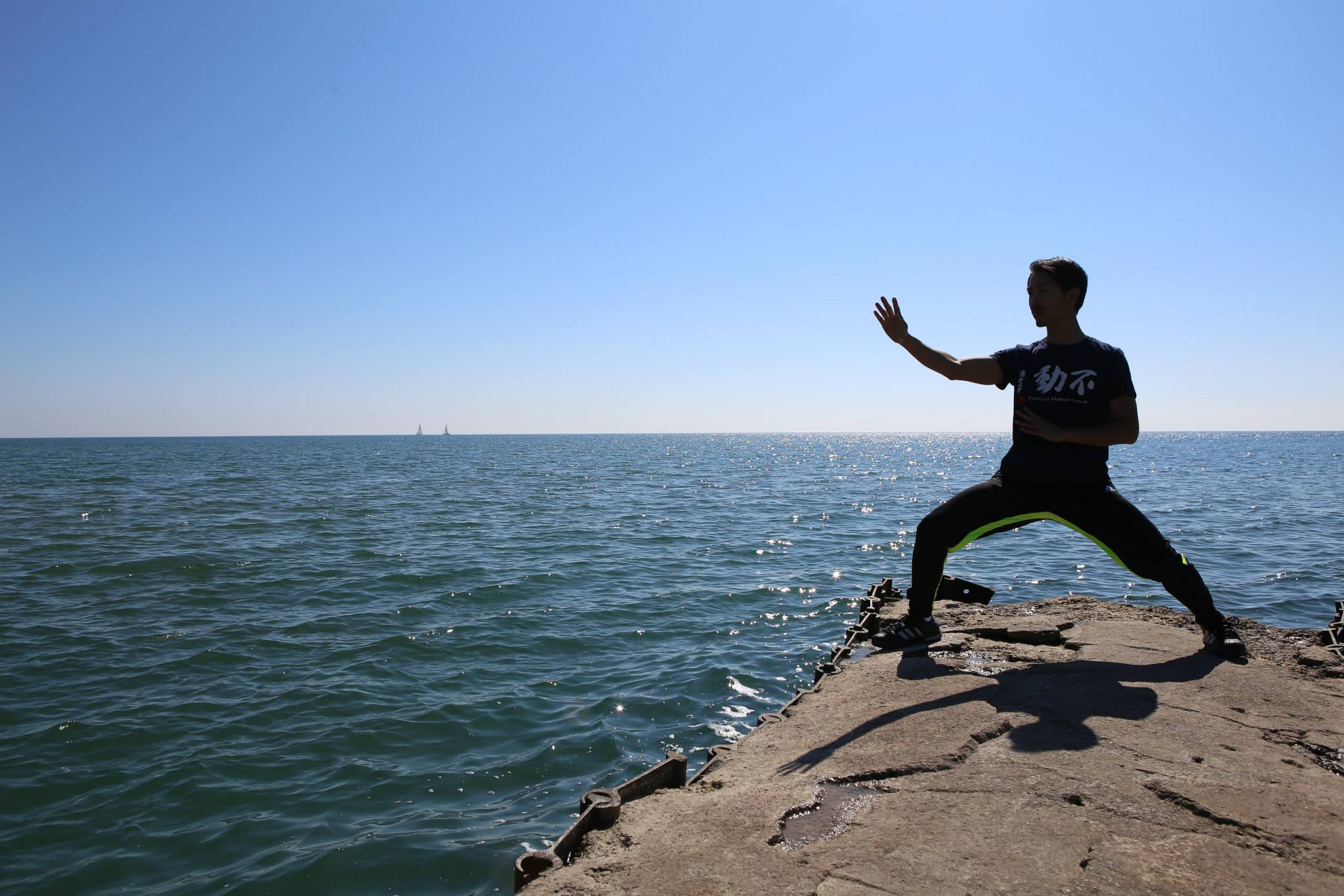
Positive circle is likely the first thing one learns in Practical Method. The following are some starter instructions for a right-side positive circle:
- The right side is considered the front side, and the left side is consider the rear side.
- Find a line that is parallel to your chest on the ground.
- Put your right foot at 45 degrees to the line with the heel touch the line.
- Put your left foot at 90 degrees to the line with the toes touch the line.

When I first studied practical method in Nov. 2009, there were a few things that made a long lasting impression. They were:
- In with elbow no hand, out with hand no elbow.
- Don’t move
- Yilu, which is made up of only positive and negative circles.
Many beginners including myself usually ask the following questions:
- How did you (Master Chen) know to do that?
- How can I not move?
- What can I do that myself?
- How do I train that?
Already some time ago now I had an interesting discussion with another person from Germany. There was one aspect showing up, which in principle could be very interessting for all of us who want to learn Taiji.
Here and there Master Chen did point out that in Taijiquan (or at least our style of Taijiquan ..) there is nothing which is related to anything we know from normal life, to the contrary, in general things are totally opposite. Right? Read more
 Shifu Chen Zhonghua often emphasizes how to learn Taijiquan. This web site has a great article called 6 Methods of Learning Tai Chi. (Read this if you have not already.) It expands and elaborates on Grandmaster Hong’s “Look, Listen, and Ask” practice method.
Shifu Chen Zhonghua often emphasizes how to learn Taijiquan. This web site has a great article called 6 Methods of Learning Tai Chi. (Read this if you have not already.) It expands and elaborates on Grandmaster Hong’s “Look, Listen, and Ask” practice method.
In motor control research, I found the neurological basis for this method of learning. There are neurological mechanisms called mirror neurons. The basic premise is when we see a person do something, mirror neurons fire off in our brain attempting to duplicate the pattern in our nervous system required to copy the movement. At first, it is an imperfect copy because it follows old neurological pathways. With repeated viewing of the action, our brains and nervous system do a really good job of creating new neurological pathways to accurately copy the movement. Read more
 After two and half month passed since my first trip to Irvine, I went back on January 31. This time, Edward came to join the group. We worked briefly on foundations. Mostly, I focused on teaching Yilu.
After two and half month passed since my first trip to Irvine, I went back on January 31. This time, Edward came to join the group. We worked briefly on foundations. Mostly, I focused on teaching Yilu.
Foundations are important. Yilu is the core. The more students know about Yilu, the more fun they can have while practicing alone. I was able to finish the first 30 forms to “Upper Cloud Hands” and “High Pat on Horse” in the morning. (We did the first 13 moves in last workshop.) Read more
From lowering stress to strengthening muscles, the Chinese marital art can help patients overcome the side effects of chemotherapy.
This is mine. What is yours?
- Continue to watch my masters’ original videos and read their original writings.
- Teach sword and broadsword.
- Stay away from the corruption of the society and of the taiji world. This means I will not copy or forward anything from the web. Every word must come from my heart, from my own experiences and from my own hand.

We must train to use a lot of power.
If you want to learn how to move a big rock and you just go up to it and use your hands to tip it back and forth, you are wasting your life. You have to get a good grip on it and try to lift it. If you can’t move it then: Read more
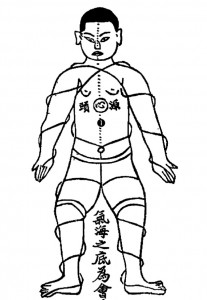
I came upon this picture from Chen Xin book 陈氏太极拳图说 Illustrated Canon of Chen Taijiquan. It strikes me that the spiral lines is drawn carefully to go through the major joints.
Spiral is the structure that allow to return incoming force outward, think of drill bits that extract material upward as it drill inward. Master Chen also explain the spiral mechanic in this video Read more
 Master Chen has said in an interview that at certain stage he felt his overall strength get much better.
Master Chen has said in an interview that at certain stage he felt his overall strength get much better.
I asked him how was his training different after that stage. His reply is that the training progress to a different dimension. Each dimensions becoming less physical.
However student must complete the first level, Read more
By John Upshaw and Levi Sowers
The interaction occurring amongst the various elements of our body are numerous and complex. This is especially true when applied to the movements, and thereof lack of movements, in Chen Style Taijiquan Practical Method. The purpose of this article is to provide a framework that will allow the reader to conceptualize the necessary movements that are congruent with the taiji principals, and inherent to the Practical Method system. The 1, 2, 3 theory of taiji movements will be the framework for describing these internal relationships. We hope that readers will be able to distinguish between what parts of the body moves from what does not move. When that is identified, then a clearer understanding of the lines that are stretched upon within oneself becomes more recognizable. Read more
We all understand the importance of “don’t move” in Practical Method. To achieve “don’t move”, there’s a pitfall need to be aware. Read more
 I believe that what happens to a connected person’s body when being pushed can be understood by understanding how a trampoline works. Read more
I believe that what happens to a connected person’s body when being pushed can be understood by understanding how a trampoline works. Read more
 Any serious Taijiquan practitioner should develop the ability to listen and observe. Read more
Any serious Taijiquan practitioner should develop the ability to listen and observe. Read more
 If I were asked what I thought the key to learning Taijiquan was, I would have to say that it is the ability to break and change old habits, both physical and mental. Because habits are usually formed at a very young age and have gone unnoticed for so many years, most people are slaves to their habits. Bad habits are usually very difficult to identify and in most cases, nearly impossible to break. Like everything else, I feel that in order to be able to understand and deal with a certain issue, one needs to go deep into the mind and explore its roots and how it actually functions in the human psyche. Read more
If I were asked what I thought the key to learning Taijiquan was, I would have to say that it is the ability to break and change old habits, both physical and mental. Because habits are usually formed at a very young age and have gone unnoticed for so many years, most people are slaves to their habits. Bad habits are usually very difficult to identify and in most cases, nearly impossible to break. Like everything else, I feel that in order to be able to understand and deal with a certain issue, one needs to go deep into the mind and explore its roots and how it actually functions in the human psyche. Read more
 Once the student is more advanced and the process of opening up the body is well under way, the body will naturally start adopting many of the fundamental principles of Taijiquan. When the practitioner is able to demonstrate that his mind and body both have a good grasp of such things as connectivity, separation, differential in movement and spiraling, the body will be able to move in such a way that the limbs will be powered by rotations occurring in different parts of the body, much like a gearbox. Once this has been achieved, the next step is for the student to meticulously go through each move in the form and learn its applications. In this step of the systematic process, the student will be required to experiment with and refine all of his knowledge and understanding and start applying it to real situations. This will help consolidate and solidify the practitioner’s overall understanding of the different movements of the form as their function and purpose will progressively become clearer. This is the point where everything starts to finally make sense. Read more
Once the student is more advanced and the process of opening up the body is well under way, the body will naturally start adopting many of the fundamental principles of Taijiquan. When the practitioner is able to demonstrate that his mind and body both have a good grasp of such things as connectivity, separation, differential in movement and spiraling, the body will be able to move in such a way that the limbs will be powered by rotations occurring in different parts of the body, much like a gearbox. Once this has been achieved, the next step is for the student to meticulously go through each move in the form and learn its applications. In this step of the systematic process, the student will be required to experiment with and refine all of his knowledge and understanding and start applying it to real situations. This will help consolidate and solidify the practitioner’s overall understanding of the different movements of the form as their function and purpose will progressively become clearer. This is the point where everything starts to finally make sense. Read more
In 2009 on Daqingshan, Master Chen Zhonghua instructed me to keep one point on my body stable and fixed during push hands practice. The location of the point was up to me; I could make it be the lower back, rear foot, etc. However, the most important thing was to maintain the integrity and stability of the chosen point. Read more
of
Grandmaster Hong Junsheng
General Principles
o Peng
Peng has been one of the most talked about topics in Taijiquan. Hong defined Peng as having two meanings: one is the upward expanding action of ward-off and the other the overall combined expanding energy that permeates all moves of Taiji. It is the latter meaning of Peng that is most important to him. “Without Peng, there is no Taiji.” Read more
Yi Lu is one of two forms in the Chen style Taijiquan lineage of Chen Chanxin who condensed the postures of the 7 barehand forms of Chen Wanting into 2 forms; Yi Lu and Er Lu. Yi Lu is the training form of Chen style Taijiquan.
One of the most important tasks of Hunyuan Qigong practice is to “calm down the mind of the monkey and the intent of the horse.”
Read more
 When I first heard Master Chen said “not-on not-off” in push hand a few years ago, I thought it was impossible. We either push (on), or not push (off). Through years of training, I slowly come to understand that “not-on not-off” is the result of “peng”, or Yin Yang separation.
When I first heard Master Chen said “not-on not-off” in push hand a few years ago, I thought it was impossible. We either push (on), or not push (off). Through years of training, I slowly come to understand that “not-on not-off” is the result of “peng”, or Yin Yang separation.
A few days ago, after I wrote about stepping training by hugging a tree, I dreamed about a new exercise to help students experiencing “not-on not-off” by pushing a tree. Read more
For those of you that come from other taichi backgrounds and now do the Practical Method, I’m curious as to what led you along this path. Also, what was your first impression of the Practical Method style? I’ll tell you a little about my story. Read more
During the recent Chen Taiji Seminar in early Mar 2012 conducted by Master Chen Zhong Hua, he used an analogy of how striking in Taiji is like being “struck by a bullet.” Read more
At DaQingShan, Master Chen was discussing push hand with someone, I was observing at the side, I could not resist and said “I have a method”. Master Chen, upon hearing, stood aside, the other person kept the same posture, I used his original posture, applied a effective technique. I held on to that person, as he was working with me, I could not let him fall.
Read more
架子
“架子”是“拳架”一词的更口语,更随意的说法。练太极的都把“架子”挂在嘴边上。练套路叫“走架”,叫“盘架子”。师傅对生徒练的套路里的错误加以纠正,以及为提高生的套路水平而加以指点,都叫“拨架子”,因为“拨”字,含有“拨正”和“点拨”的意思。 Read more
It was a beautiful morning in Phoenix, Arizona. Went to my Tai Chi class at 7:30am. Adam, Read more
 Eventually, the positioning of the feet and stances must also be taken into consideration and perfected. When the body is properly connected, the legs are naturally brought in and the knees pushed out as far as possible without compromising the structure of the rest of body. Read more
Eventually, the positioning of the feet and stances must also be taken into consideration and perfected. When the body is properly connected, the legs are naturally brought in and the knees pushed out as far as possible without compromising the structure of the rest of body. Read more
When Master asked me to write about Taiji from the point of view of a dancer, I thought it was a rather insurmountable task. I feel that I know so little about both. Yes, I have danced what is collectively known as Salsa for 18 years, but the old adage is that the more you know, the more you don’t know. I have been reluctant to put anything on paper. Read more
In a few days we will have some videos to post on our work today. Thanks to K. S. Loke of Malaysia and Michael Koh of Singapore for arranging this. I hope we will have some good teaching/learning videos of the foundations of the Practical Method out of this.
 The circle, simply put, is the basis of every move in the Taijiquan Practical Method system. Every action or movement in the form is actually a part or variation of either the negative or positive circle. Therefore, common sense would suggest that one must gain a deep understanding of the circle and its mechanics in order to have any kind of understanding of Taijiquan and its practical applications. Read more
The circle, simply put, is the basis of every move in the Taijiquan Practical Method system. Every action or movement in the form is actually a part or variation of either the negative or positive circle. Therefore, common sense would suggest that one must gain a deep understanding of the circle and its mechanics in order to have any kind of understanding of Taijiquan and its practical applications. Read more
I remember that when I was a young, I hated doing calligraphy. All my arm muscles including those of my shoulder and back would tense-up and hurt. I hated even more those lectures where teachers would spend the entire class making me take notes non-stop. But with time, my hand learned when not to involve my wrist, elbow and shoulder. And now as an adult who practiced writing for years, I can write for long periods of time without getting tired. Read more
在国内,打太极拳的随处可见;在国外也不罕见。如果您稍微留点儿心,就会发现,绝大多数人走架的时候,手的动作多、动作大而且繁复。推手时也如是,净看见两个人用手互相推拉撕扯了。 Read more


